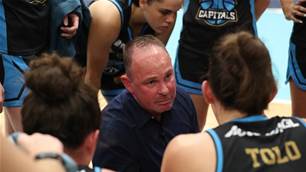The 19-year-old, 188cm dynamo from Duke University is a likely candidate to be the top pick in the NBA draft this June.
The 19-year-old, 188cm dynamo from Duke University is a likely candidate to be the top pick in the NBA draft this June.
 Kyrie Irving taking the shot
Kyrie Irving taking the shotImages: Getty Images
As the elite teams of the National Basketball Association focus on the here and now of the play-offs, those at the other end of the spectrum are looking ahead to the future, beyond even the possible industrial dispute that will shut down the league. For the likes of the last-place Cleveland Cavaliers, forced to suffer through the loss-filled aftermath of LeBron James’ departure, hope is embodied in the form of Kyrie Irving. The 19-year-old, 188cm dynamo from Duke University is a likely candidate to be the top pick in the NBA draft this June. If he is, it’ll be the second time in six years that the number-one will have come from that underrated hoops mecca, Melbourne.
WHAT’S HIS STORY?
Irving’s father, Drederick, was a player, a small-college star in Boston who landed at the Bulleen Boomers back in the early 1990s when they competed in the South East Australian Basketball League, the level below the NBL. He made the All-SEABL second team in 1992, the same year his son Kyrie was born, and he grew up in the Melbourne suburb of Kew.
Before the boy’s second birthday, the Irvings moved from Australia’s Garden State to America’s, New Jersey. Tragedy struck in 1996 when Kyrie’s mother, Elizabeth, died suddenly, and it drew father and son closer. Drederick took a job on Wall Street, eventually becoming a bond trader, while Kyrie proceeded to develop into one of the top high school players in the United States.
He didn’t escape the notice of one of Drederick’s former coaches at Bulleen, Australian national team coach Brett Brown. Aware that Kyrie retained dual citizenship, Brown pitched the possibility of Irving playing for Australia, with the ultimate lure of a spot with the Boomers at next year’s Olympics. Irving chose the US, leading his country to victory in the Americas qualifier for the upcoming Under-19 World Championship.
While it’s highly unlikely Irving will be able to crack a loaded US line-up for London, he did find a way to play for US national team coach Mike Krzyzewski by heading to Duke. Coach K was coming off his fourth national title victory, second-most in the history of the US college competition, and the addition of Irving inspired visions of a repeat. Duke won its first eight games by an average of 23, with its star freshman averaging 17.4 points and 5.1 assists, but Irving then sustained an injury to his toe that kept him out for the rest of the season. The toe became the most scrutinised body part in all of college baske tball. Another set of interested observers, NBA scouts, had seen enough in Irving’s brief audition to be convinced of his potential.
WHO’S HE LIKE?
The most oft-cited comparison for Irving is current New Orleans Hornets superstar Chris Paul. The hoops nerds out there also invoke the name of Jay Williams, another New Jersey product who excelled at Duke, was chosen second in the 2002 draft behind Yao Ming and saw his promising NBA career abbreviated by a horrific motorcycle accident.
Irving’s game is out of the point guard manual, a mix of sleight-of-hand quickness and savvy distribution. Where today’s top practitioners at the position range in style from the jet-like Derrick Rose of Chicago to New Jersey’s Deron Williams and his all-court game, Irving’s the kind of classic general who just makes his team-mates better.
With the likes of Paul, Rose and Williams in their primes (as well as Rajon Rondo, Russell Westbrook and Stephen Curry), veteran stars Steve Nash and Jason Kidd still vital, and Irving arriving only a year after Washington chose the Rose-like John Wall as the number-one pick, the coming seasons shape as a golden era of NBA point guards. Size has traditionally been prized at the top of the NBA draft (one reason why Andrew Bogut went first in 2005), but the case for Irving has been strengthened by the notion that if your team doesn’t have an elite point guard , you’ll have to contend with those that do. It’s such a high-level talent glut that it’s almost bad timing that Aussie point guard Patty Mills – who made good strides at Portland this season – arrived when he did.
‒ Jeff Centenera
What do they say?
“Honestly, I just want to not mess him up ... Just let him play.”
–Duke University and US national team coach Mike Krzyzewski.
Related Articles

NBA star launches Tour for underrepresented kids

Opals legend Jackson to make incredible return to basketball













